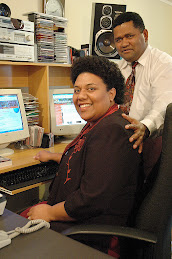 Proving that anything is possible including cooking, Hibiscus King contestant Aseri Makutu took on the challenge of expanding his cooking horizon.
Proving that anything is possible including cooking, Hibiscus King contestant Aseri Makutu took on the challenge of expanding his cooking horizon. For some one who has spent years watching others cook while lending a hand with preparations, Aseri was all natural when the request came.
Proud of this one dish he can finally call his own, Aseri like most his age seldom cooks but enjoys helping out in the kitchen whenever his services are needed.
He decided to cook kai vaka soso and the miracle in all this is that he did not need his aunties in the kitchen telling him what to do. The recipe kai vaka soso means mixing something with kai or mussels. In this case, it is frying fresh vegetables with kai topped with creamy lolo and garnished with coriander and grated carrot.
Aseri prepared this rather delicious recipe with a smile all the way through not only because it was going to be his first ever cooked product but for him a tasty meal is one that is made with a happy heart.
"My cousin's wife used to do this so I actually learned this a few days ago. All the ingredients are from Sigatoka, right down to the kumala," he said. "I chose this recipe because it is a fairly simple dish to make and it has health benefits with the vegetables included. "It doesn't take long to prepare and make and it's very tasty. This is one of many recipes with kai in it. "The stock from the boiled kai is mixed with grated coconut to keep the taste and flavour of the kai."
The support from his family was overwhelming especially for a little cooking op like this.
His aunt went to Sigatoka over the weekend to get him the ingredients needed for this dish and mind you the taste of home grown vegetables from the 'salad bowl' of Fiji is like no other. His final touch and presentation of his recipe was flawless and Aseri most definitely would have passed home economics if he took it in high school.
The 22-year old is originally from Cuvu in Nadroga and is a second year student at the University of the South Pacific. Born and bred in Sigatoka, Aseri is the eldest of five and although he wanted to be a doctor when he was younger, he has decided to set his sights on becoming a marine scientist.
"I am doing a bachelor of science majoring in marine science and chemistry. I never thought I would be in an event like the Hibiscus. "I used to be a really shy person but with preparations over the past few months, I have become more confident and open to new challenges. "I thought Hibiscus was all about glamour and just sitting up on stage with lots of people looking at you.
"It is more than that. It is more about people and charity and the whole experience has been an exciting one."
Aseri is sponsored by Lala's Menswear and is grateful for the support received from both his sponsor and family members.
Aseri's kai vaka soso
Preparation time: 10 minutes
Cooking time: 20 minutes
Serves: 4 people
Ingredients:
1 heap kai or mussels
2 diced tomatoes
1/2 diced onion
1 grated carrot
Crushed garlic, ginger
Diced coriander
Diced celery and capsicum
1 tbsp soya bean oil
3 grated coconuts or ready to cook lolo
Method:
* Wash and clean kai or mussels. Leave to boil for 10-15 minutes. Once kai is cooked, pour leftover kai stock accordingly with grated coconuts and squeeze out lolo or coconut milk, strain lolo and leave aside.
* Dice kai into small pieces. Heat a little oil in frying pan, add onions and garlic and fry until golden brown.
* Add and stir celery, capsicum and tomatoes.
* Add diced kai into the pan and fry.
* Add salt according to preference.
* Squeeze ginger juice over mixed ingredients and leave to simmer for about 2 minutes.
* In a separate pot, pour in lolo and leave to boil for about 2 minutes on medium heat. Avoid over boiling the lolo.
Final touch:
* Wash and clean kai shells and place on a plate or in a serving bowl.
* In each shell, place a spoon full of fried kai with vegetables.
* Coat each shell with boiled lolo cream and garnish with grated carrot and coriander.
* Enjoy with a plate of sweet potato or kumala and a glass of orange juice.
Adpted from Fijitimes Online


